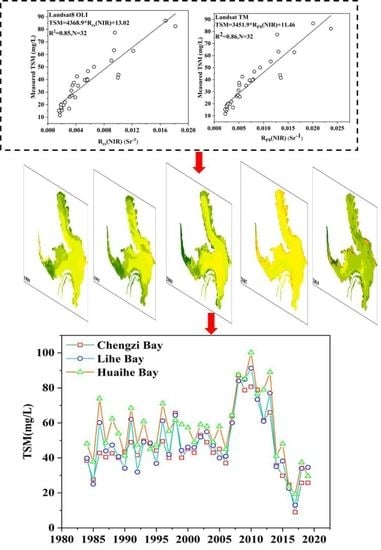Characteristics of the Total Suspended Matter Concentration in the Hongze Lake during 1984–2019 Based on Landsat Data
Abstract
:1. Introduction
2. Materials and Methods
2.1. Study Area
2.2. In-Situ Data
2.2.1. Spectral Data Collection
2.2.2. Suspended Matter Concentration Measurement
2.2.3. Meteorological Data
2.2.4. Economic and Demographic Data
2.3. Satellite Data
2.4. Performance Evaluation
3. Results
3.1. Development and Assessment of the TSM Retrieval Algorithm
3.2. Spatial Change of TSM Concentrations in the Hongze Lake in the Past 36 Years
3.3. Seasonal Variations in TSM Concentration in the Hongze Lake
4. Discussion
4.1. Suitability and Uncertainty of TSM Estimation Results
4.2. Analysis of Influencing Factors on Inter-annual Variations in TSM Concentration in the Hongze Lake
4.3. Potential Factors for Seasonal Changes in TSM
4.4. Implications for the Hongze Lake Water Quality Monitoring and Ecosystem Restoration
5. Conclusions
References
Author Contributions
Funding
Acknowledgments
Conflicts of Interest
Appendix A
| Year | January | February | March | April | May | June | July | August | Sepetember | October | November | December |
|---|---|---|---|---|---|---|---|---|---|---|---|---|
| 1984 | 1 | 1 | ||||||||||
| 1985 | 1 | 2 | 1 | |||||||||
| 1986 | 1 | 1 | 2 | |||||||||
| 1987 | 1 | 1 | 2 | 1 | ||||||||
| 1988 | 1 | 1 | 1 | 1 | 1 | 2 | 2 | 1 | ||||
| 1989 | 2 | 2 | 1 | 1 | 1 | 2 | 1 | 1 | ||||
| 1990 | 1 | 1 | 1 | 2 | ||||||||
| 1991 | 2 | 1 | 1 | |||||||||
| 1992 | 1 | 1 | 1 | 1 | 1 | 1 | ||||||
| 1993 | 1 | 1 | 1 | 1 | 1 | |||||||
| 1994 | 1 | 1 | 2 | 1 | ||||||||
| 1995 | 2 | 1 | 1 | 1 | 1 | |||||||
| 1996 | 1 | 1 | 2 | |||||||||
| 1997 | 1 | 1 | 1 | |||||||||
| 1998 | 1 | 1 | 2 | 3 | 2 | |||||||
| 1999 | 1 | 1 | 2 | |||||||||
| 2000 | 1 | 1 | 2 | 1 | ||||||||
| 2001 | 1 | 1 | 1 | 1 | 2 | |||||||
| 2002 | 1 | 2 | 1 | 1 | ||||||||
| 2003 | 1 | 1 | 1 | 1 | 1 | |||||||
| 2004 | 1 | 1 | 1 | 2 | 2 | |||||||
| 2005 | 1 | 1 | 2 | 1 | ||||||||
| 2006 | 1 | 1 | 2 | 1 | ||||||||
| 2007 | 1 | 1 | 1 | |||||||||
| 2008 | 1 | 1 | ||||||||||
| 2009 | 2 | 2 | 1 | 1 | ||||||||
| 2010 | 1 | 1 | ||||||||||
| 2011 | 2 | 1 | 1 | |||||||||
| 2013 | 1 | 2 | 1 | 1 | ||||||||
| 2014 | 2 | 1 | 1 | 1 | 1 | 1 | 1 | |||||
| 2015 | 1 | 1 | 1 | 1 | ||||||||
| 2016 | 1 | 1 | 1 | |||||||||
| 2017 | 1 | 1 | 1 | |||||||||
| 2018 | 1 | 2 | 1 | 1 | ||||||||
| 2019 | 1 | 1 |
References
- Cai, Y.; Ke, C.-Q.; Shen, X. Variations in water level, area and volume of Hongze Lake, China from 2003 to 2018. J. Great Lakes Res. 2020, 46, 1511–1520. [Google Scholar] [CrossRef]
- Wu, Y.; Dai, R.; Xu, Y.; Han, J.; Li, P. Statistical assessment of water quality issues in Hongze Lake, China, related to the operation of a water diversion project. Sustainability 2018, 10, 1885. [Google Scholar] [CrossRef] [Green Version]
- Zhang, M.; Tang, J.; Dong, Q.; Song, Q.; Ding, J. Retrieval of total suspended matter concentration in the Yellow and East China Seas from MODIS imagery. Remote Sens Environ. 2010, 114, 392–403. [Google Scholar] [CrossRef]
- Miller, R.L.; McKee, B.A. Using MODIS Terra 250 m imagery to map concentrations of total suspended matter in coastal waters. Remote Sens Environ. 2004, 93, 259–266. [Google Scholar] [CrossRef]
- Du, C.; Li, Y.; Wang, Q.; Liu, G.; Zheng, Z.; Mu, M.; Li, Y. Tempo-spatial dynamics of water quality and its response to river flow in estuary of Taihu Lake based on GOCI imagery. Environ. Sci. Pollut. Res. 2017, 24, 28079–28101. [Google Scholar] [CrossRef] [PubMed]
- Qin, B.; Yang, L.; Chen, F.; Zhu, G.; Zhang, L.; Chen, Y. Mechanism and control of lake eutrophication. Chin. Sci. Bull. 2006, 51, 2401–2412. [Google Scholar] [CrossRef]
- Qin, B.; Zhu, G. The nutrient forms, cycling and exchange flux in the sediment and overlying water system in lakes from the middle and lower reaches of Yangtze River. Sci. China Ser. D 2006, 49, 1. [Google Scholar] [CrossRef]
- Liu, H.; Li, Q.; Shi, T.; Hu, S.; Wu, G.; Zhou, Q. Application of sentinel 2 MSI images to retrieve suspended particulate matter concentrations in Poyang Lake. Remote Sens. 2017, 9, 761. [Google Scholar] [CrossRef] [Green Version]
- Ciancia, E.; Campanelli, A.; Lacava, T.; Palombo, A.; Pascucci, S.; Pergola, N.; Pignatti, S.; Satriano, V.; Tramutoli, V. Modeling and multi-temporal characterization of total suspended matter by the combined use of Sentinel 2-MSI and Landsat 8-OLI data: The Pertusillo Lake case study (Italy). Remote Sens. 2020, 12, 2147. [Google Scholar] [CrossRef]
- Cao, Z.; Duan, H.; Feng, L.; Ma, R.; Xue, K. Climate- and human-induced changes in suspended particulate matter over Lake Hongze on short and long timescales. Remote Sens. Environ. 2017, 192, 98–113. [Google Scholar] [CrossRef]
- Usali, N.; Ismail, M.H. Use of remote sensing and GIS in monitoring water quality. J. Sustain. Dev. 2010, 3, 228. [Google Scholar] [CrossRef]
- Topp, S.N.; Pavelsky, T.M.; Jensen, D.; Simard, M.; Ross, M.R. Research trends in the use of remote sensing for inland water quality science: Moving towards multidisciplinary applications. Water 2020, 12, 169. [Google Scholar] [CrossRef] [Green Version]
- Flores-Anderson, A.I.; Griffin, R.; Dix, M.; Romero-Oliva, C.S.; Ochaeta, G.; Skinner-Alvarado, J.; Ramirez Moran, M.V.; Hernandez, B.; Cherrington, E.; Page, B.; et al. Hyperspectral satellite remote sensing of water quality in Lake Atitlán, Guatemala. Front. Environ. Sci. 2020, 8, 7. [Google Scholar] [CrossRef]
- Chawla, I.; Karthikeyan, L.; Mishra, A.K. A review of remote sensing applications for water security: Quantity, quality, and extremes. J. Hydrol. 2020, 585, 124826. [Google Scholar] [CrossRef]
- Shi, K.; Zhang, Y.; Song, K.; Liu, M.; Zhou, Y.; Zhang, Y.; Li, Y.; Zhu, G.; Qin, B. A semi-analytical approach for remote sensing of trophic state in inland waters: Bio-optical mechanism and application. Remote Sens. Environ. 2019, 232, 111349. [Google Scholar] [CrossRef]
- Eraso, R.; de Lourdes Galo, M.; Alcântara, E.; Shimabukuro, M.; Carmo, A. Locally tuned model to map the chlorophyll-a and the trophic state in Porto Primavera reservoir using MODIS/Terra images. Modeling Earth Syst. Environ. 2018, 4, 39–47. [Google Scholar] [CrossRef]
- Yu, X.; Lee, Z.; Shen, F.; Wang, M.; Wei, J.; Jiang, L.; Shang, Z. An empirical algorithm to seamlessly retrieve the concentration of suspended particulate matter from water color across ocean to turbid river mouths. Remote Sens. Environ. 2019, 235, 111491. [Google Scholar] [CrossRef]
- Pan, Y.; Shen, F.; Wei, X. Fusion of Landsat-8/OLI and GOCI Data for Hourly Mapping of Suspended Particulate Matter at High Spatial Resolution: A Case Study in the Yangtze (Changjiang) Estuary. Remote Sens. 2018, 10, 158. [Google Scholar] [CrossRef] [Green Version]
- Du, C.; Wang, Q.; Li, Y.; Lyu, H.; Zhu, L.; Zheng, Z.; Wen, S.; Liu, G.; Guo, Y. Estimation of total phosphorus concentration using a water classification method in inland water. Int. J. Appl. Earth Obs. 2018, 71, 29–42. [Google Scholar] [CrossRef]
- Shi, K.; Zhang, Y.; Zhu, G.; Qin, B.; Pan, D. Deteriorating water clarity in shallow waters: Evidence from long term MODIS and in-situ observations. Int. J. Appl. Earth Obs. 2018, 68, 287–297. [Google Scholar] [CrossRef]
- Buznikov, A.A.; Lakhtanov, G.A.; Laine, P.; Minkkinen, P.; Rakushin, P.B. Development of water quality models for remote sensing of the Saimaa lake system. Earth Obs. Remote Sens. 2001, 16, 997–1006. [Google Scholar]
- Zhang, Y.; Huang, Z.; Fu, D.; Tsou, J.Y.; Jiang, T.; Liang, X.S.; Lu, X. Monitoring of chlorophyll-a and sea surface silicate concentrations in the south part of Cheju island in the East China sea using MODIS data. Int. J. Appl. Earth Obs. 2018, 67, 173–178. [Google Scholar] [CrossRef]
- Chen, J.; Zhu, W.-N.; Tian, Y.Q.; Yu, Q. Estimation of Colored Dissolved Organic Matter From Landsat-8 Imagery for Complex Inland Water: Case Study of Lake Huron. IEEE Trans. Geosci. Remote Sens. 2017, 55, 2201–2212. [Google Scholar] [CrossRef]
- Engel, A.; Bracher, A.; Dinter, T.; Endres, S.; Grosse, J.; Metfies, K.; Peeken, I.; Piontek, J.; Salter, I.; Nöthig, E.-M. Inter-Annual Variability of Organic Carbon Concentration in the Eastern Fram Strait During Summer (2009–2017). Front. Mar. Sci. 2019, 6, 187. [Google Scholar] [CrossRef]
- Zheng, Z.; Ren, J.; Li, Y.; Huang, C.; Liu, G.; Du, C.; Lyu, H. Remote sensing of diffuse attenuation coefficient patterns from Landsat 8 OLI imagery of turbid inland waters: A case study of Dongting Lake. Sci. Total Environ. 2016, 573, 39–54. [Google Scholar] [CrossRef] [PubMed]
- Ogashawara, I. Advances and limitations of using satellites to monitor cyanobacterial harmful algal blooms. Acta Limnol. Bras. 2019, 31. [Google Scholar] [CrossRef] [Green Version]
- Zhou, B.; Shang, M.; Feng, L.; Shan, K.; Feng, L.; Ma, J.; Liu, X.; Wu, L. Long-term remote tracking the dynamics of surface water turbidity using a density peaks-based classification: A case study in the Three Gorges Reservoir, China. J. Ecol. Indic. 2020, 116, 106539. [Google Scholar] [CrossRef]
- Pham, Q.; Ha, N.; Pahlevan, N.; Oanh, L.; Nguyen, T.; Nguyen, N.J.R.S. Using Landsat-8 Images for Quantifying Suspended Sediment Concentration in Red River (Northern Vietnam). Remote Sens. 2018, 10, 1841. [Google Scholar] [CrossRef] [Green Version]
- Tian, L.; Wai, O.W.H.; Chen, X.; Li, W.; Li, J.; Li, W.; Zhang, H. Retrieval of total suspended matter concentration from Gaofen-1 Wide Field Imager (WFI) multispectral imagery with the assistance of Terra MODIS in turbid water—Case in Deep Bay. Int. J. Remote Sens. 2016, 37, 3400–3413. [Google Scholar] [CrossRef]
- Zhan, W.; Wu, J.; Wei, X.; Tang, S.; Zhan, H.J.C.S.R. Spatio-temporal variation of the suspended sediment concentration in the Pearl River Estuary observed by MODIS during 2003–2015. Cont. Shelf Res. 2018, 172, 22–32. [Google Scholar] [CrossRef]
- Dekker, A.G.; Vos, R.; Peters, S. Analytical algorithms for lake water TSM estimation for retrospective analyses of TM and SPOT sensor data. Int. J. Remote Sens. 2002, 23, 15–35. [Google Scholar] [CrossRef]
- Zheng, Z.; Li, Y.; Guo, Y.; Xu, Y.; Liu, G.; Du, C. Landsat-Based Long-Term Monitoring of Total Suspended Matter Concentration Pattern Change in the Wet Season for Dongting Lake, China. Remote Sens. 2015, 7, 13975–13999. [Google Scholar] [CrossRef] [Green Version]
- Zhang, Y.; Shi, K.; Zhang, Y.; Moreno-Madriñán, M.J.; Zhu, G.; Zhou, Y.; Yao, X. Long-term change of total suspended matter in a deep-valley reservoir with HJ-1A/B: Implications for reservoir management. Environ. Sci. Pollut. Res. 2019, 26, 3041–3054. [Google Scholar] [CrossRef]
- Mao, Z.; Chen, J.; Pan, D.; Tao, B.; Zhu, Q. A regional remote sensing algorithm for total suspended matter in the East China Sea. Remote Sens. Environ. 2012, 124, 819–831. [Google Scholar] [CrossRef]
- Shi, K.; Zhang, Y.; Zhu, G.; Liu, X.; Zhou, Y.; Xu, H.; Qin, B.; Liu, G.; Li, Y. Long-term remote monitoring of total suspended matter concentration in Lake Taihu using 250 m MODIS-Aqua data. Remote Sens. Environ. 2015, 164, 43–56. [Google Scholar] [CrossRef]
- Lymburner, L.; Botha, E.; Hestir, E.; Anstee, J.; Sagar, S.; Dekker, A.; Malthus, T. Landsat 8: Providing continuity and increased precision for measuring multi-decadal time series of total suspended matter. Remote Sens. Environ. 2016, 185, 108–118. [Google Scholar] [CrossRef]
- Yang, H.; Kong, J.; Hu, H.; Du, Y.; Gao, M.; Chen, F. A Review of Remote Sensing for Water Quality Retrieval: Progress and Challenges. Remote Sens. 2022, 14, 1770. [Google Scholar] [CrossRef]
- Lei, S.; Wu, D.; Li, Y.; Wang, Q.; Huang, C.; Liu, G.; Zheng, Z.; Du, C.; Mu, M.; Xu, J.; et al. Remote sensing monitoring of the suspended particle size in Hongze Lake based on GF-1 data. J. Int. J. Remote Sens. 2019, 40, 3179–3203. [Google Scholar] [CrossRef]
- Tang, J.-W.; Tian, G.-L.; Wang, X.-Y.; Wang, X.-M.; Song, Q.-J. The methods of water spectra measurement and analysis I: Above-water method. Int. J. Remote Sens. 2004, 8, 37–44. [Google Scholar]
- Dekker, A.; Vos, R.; Peters, S. Comparison of remote sensing data, model results and in situ data for total suspended matter (TSM) in the southern Frisian lakes. Sci. Total Environ. 2001, 268, 197–214. [Google Scholar] [CrossRef]
- Racetin, I.; Krtalic, A.; Srzic, V.; Zovko, M. Characterization of short-term salinity fluctuations in the Neretva River Delta situated in the southern Adriatic Croatia using Landsat-5 TM. Ecol. Indic. 2020, 110, 105924. [Google Scholar] [CrossRef]
- Wu, C.F.; Wu, J.P.; Qi, J.G.; Zhang, L.; Huang, H.Q.; Lou, L.P.; Chen, Y.X. Empirical estimation of total phosphorus concentration in the mainstream of the Qiantang River in China using Landsat TM data. Int. J. Remote Sens. 2010, 31, 2309–2324. [Google Scholar] [CrossRef]
- Moses, W.J.; Gitelson, A.A.; Perk, R.L.; Gurlin, D.; Rundquist, D.C.; Leavitt, B.C.; Barrow, T.M.; Brakhage, P. Estimation of chlorophyll-a concentration in turbid productive waters using airborne hyperspectral data. J. Water Res. 2012, 46, 993–1004. [Google Scholar] [CrossRef] [Green Version]
- Baban, S.M. Detecting water quality parameters in the Norfolk Broads, UK, using Landsat imagery. Int. J. Remote Sens. 1993, 14, 1247–1267. [Google Scholar] [CrossRef]
- Alcântara, E.; Curtarelli, M.; Kampel, M.; Stech, J. Spatiotemporal total suspended matter estimation in Itumbiara reservoir with Landsat-8/OLI images. Int. J. Cartogr. 2016, 2, 148–165. [Google Scholar] [CrossRef]
- Zhu, Z. Change detection using landsat time series: A review of frequencies, preprocessing, algorithms, and applications. ISPRS J. Photogramm. Remote Sens. 2017, 130, 370–384. [Google Scholar] [CrossRef]
- Cao, Z.; Ma, R.; Duan, H.; Pahlevan, N.; Melack, J.; Shen, M.; Xue, K. A machine learning approach to estimate chlorophyll-a from Landsat-8 measurements in inland lakes. Remote Sens. Environ. 2020, 248, 111974. [Google Scholar] [CrossRef]



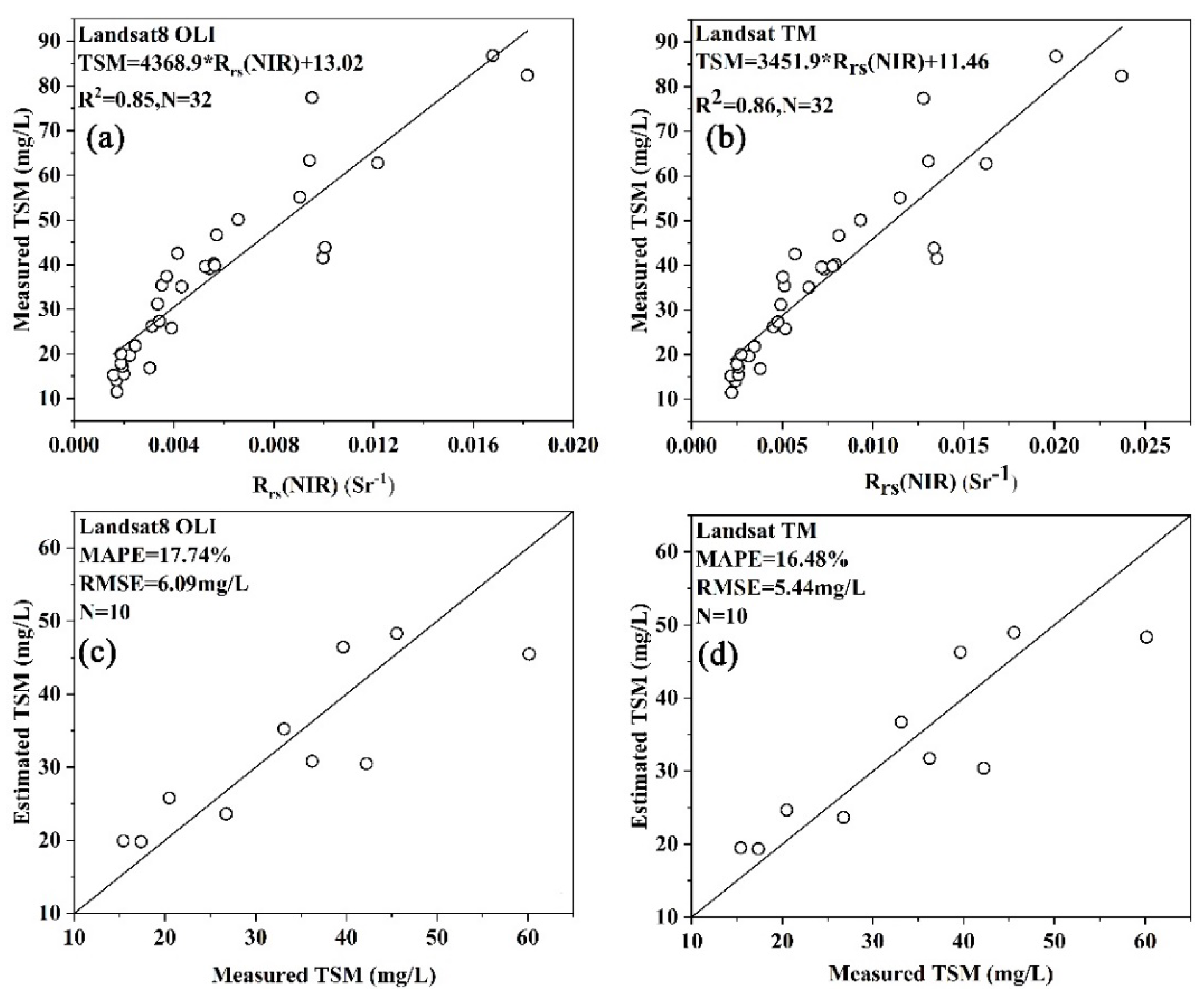

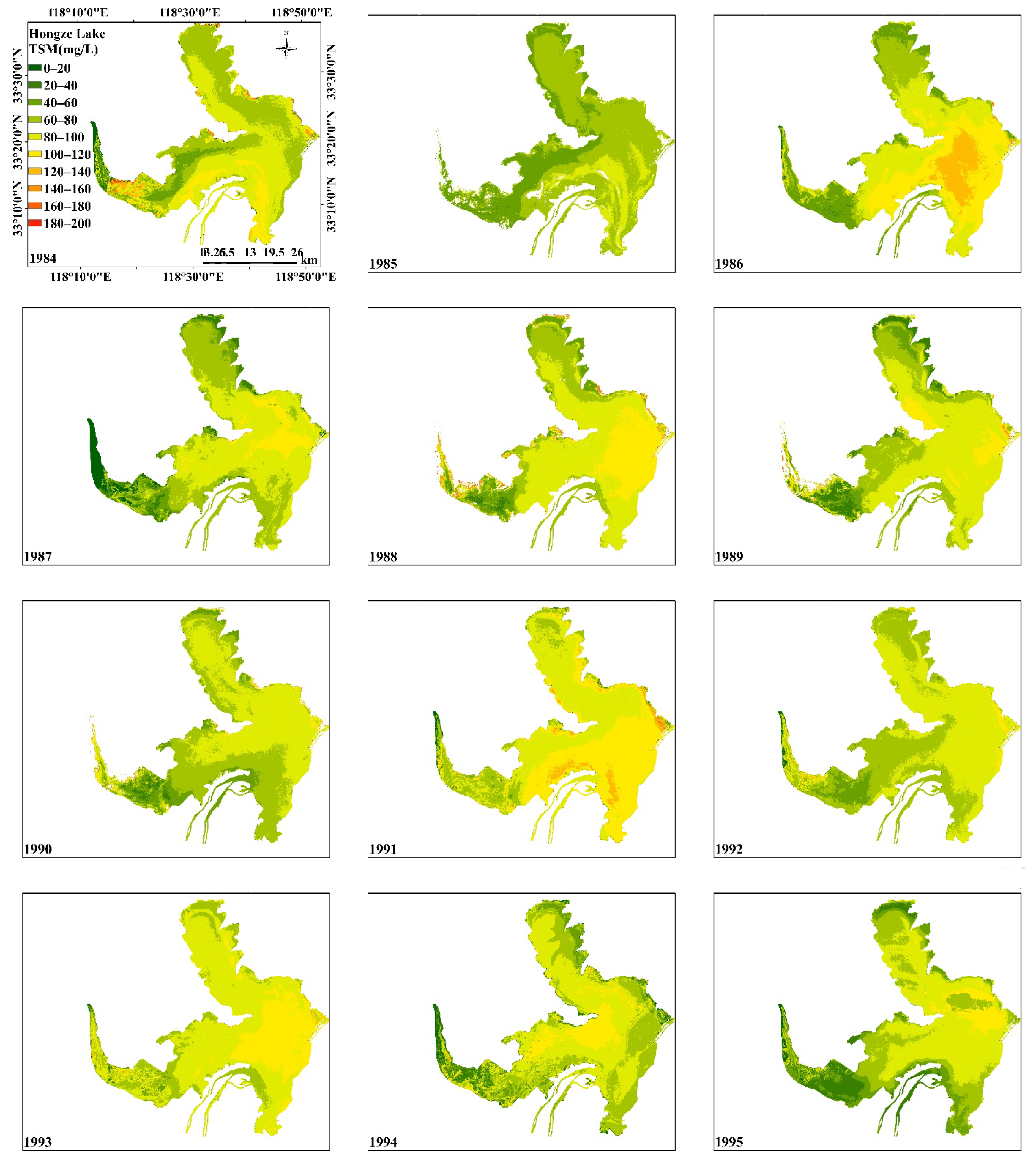

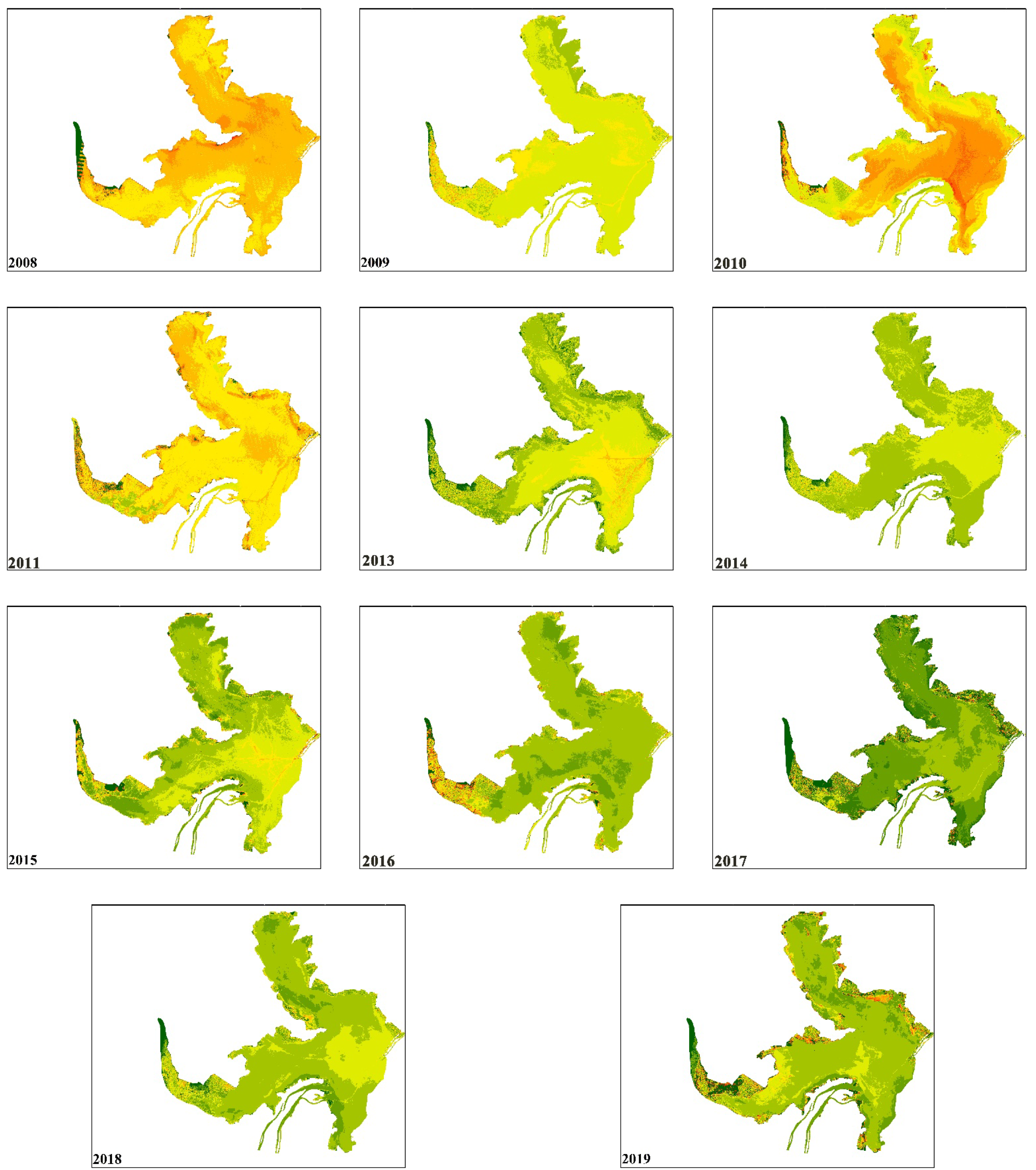
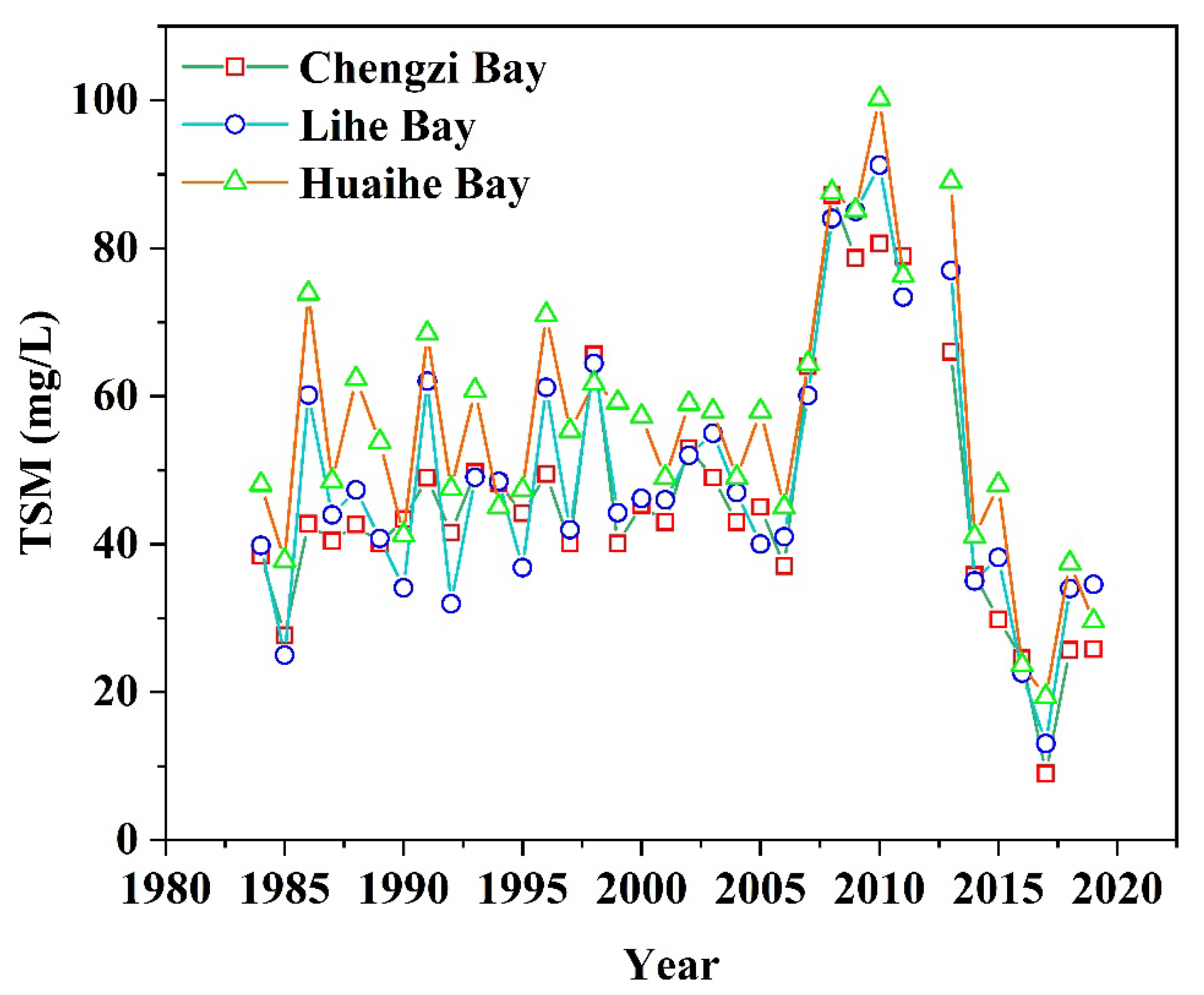
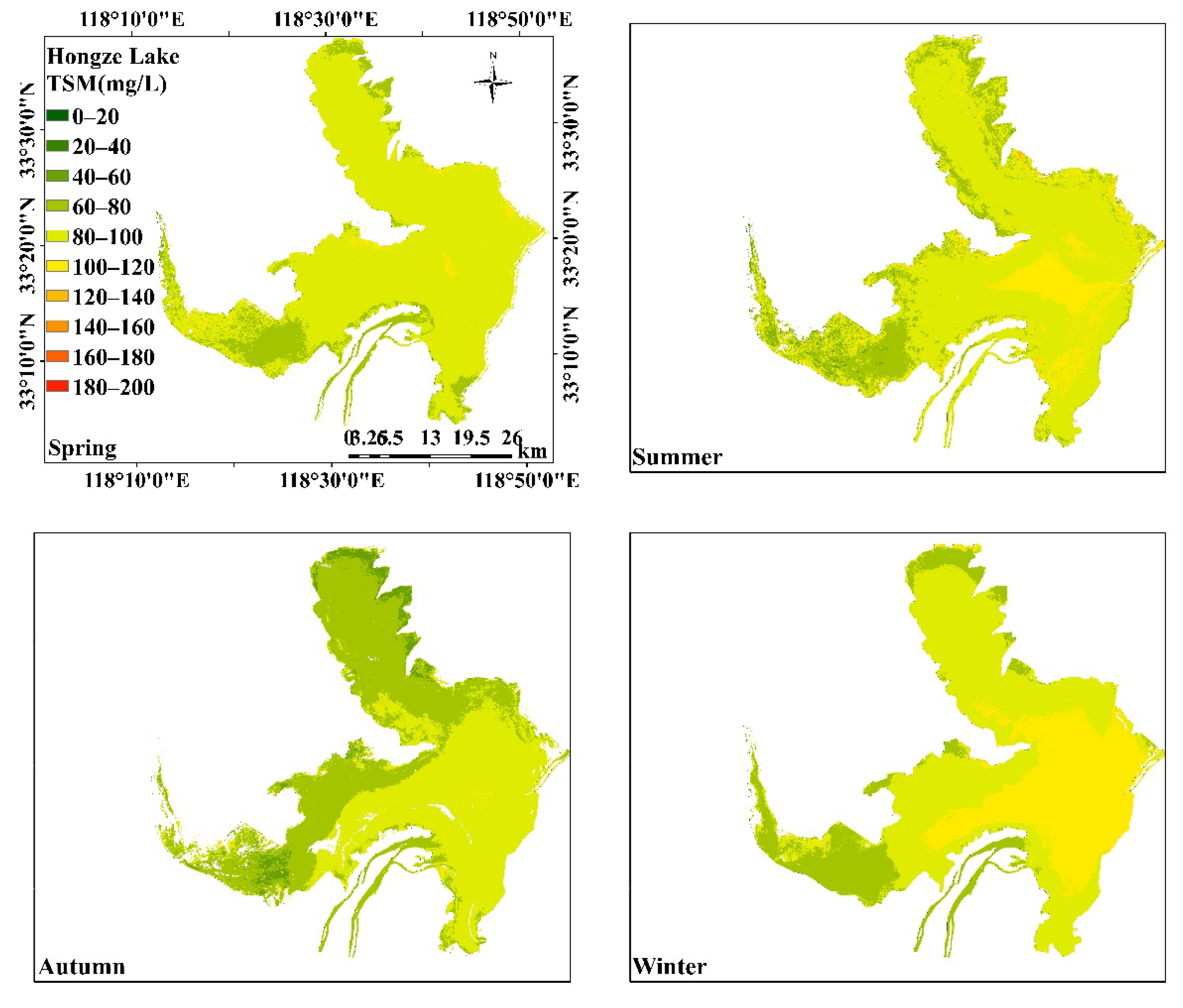
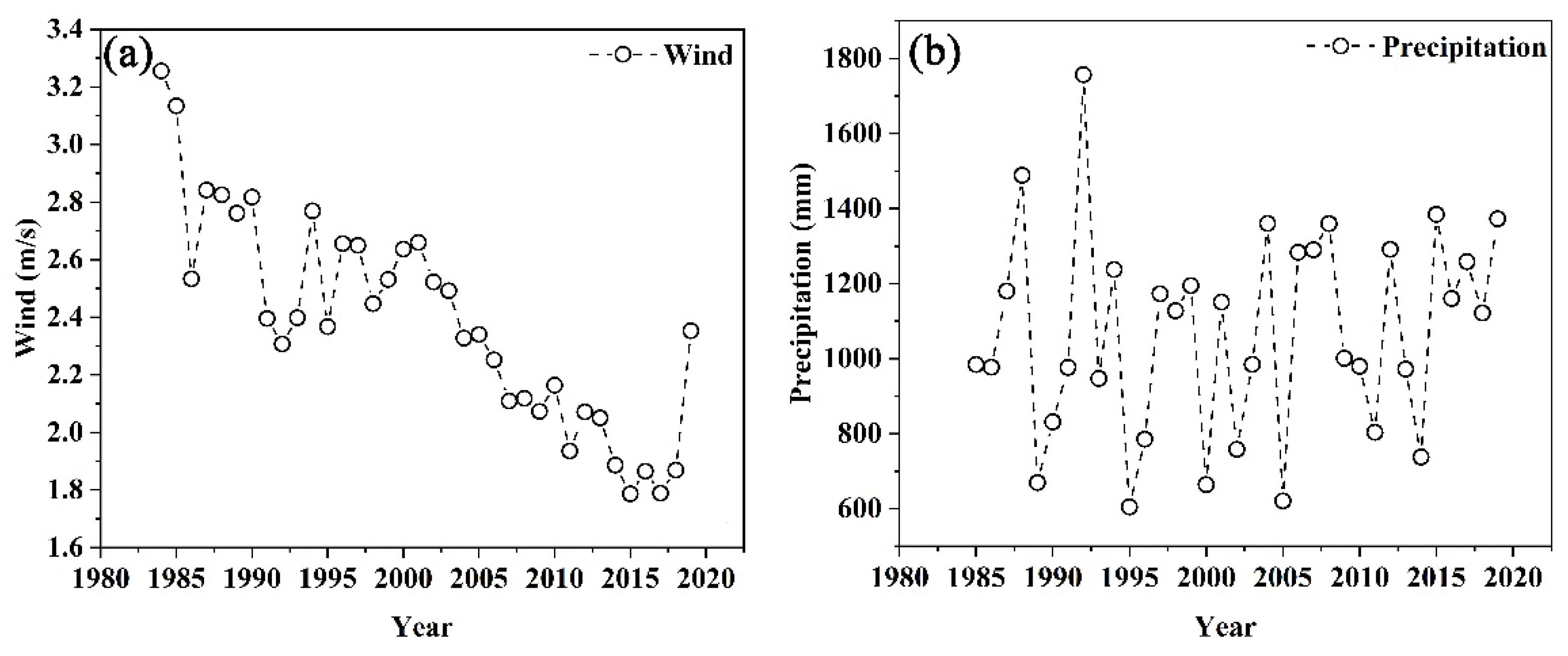
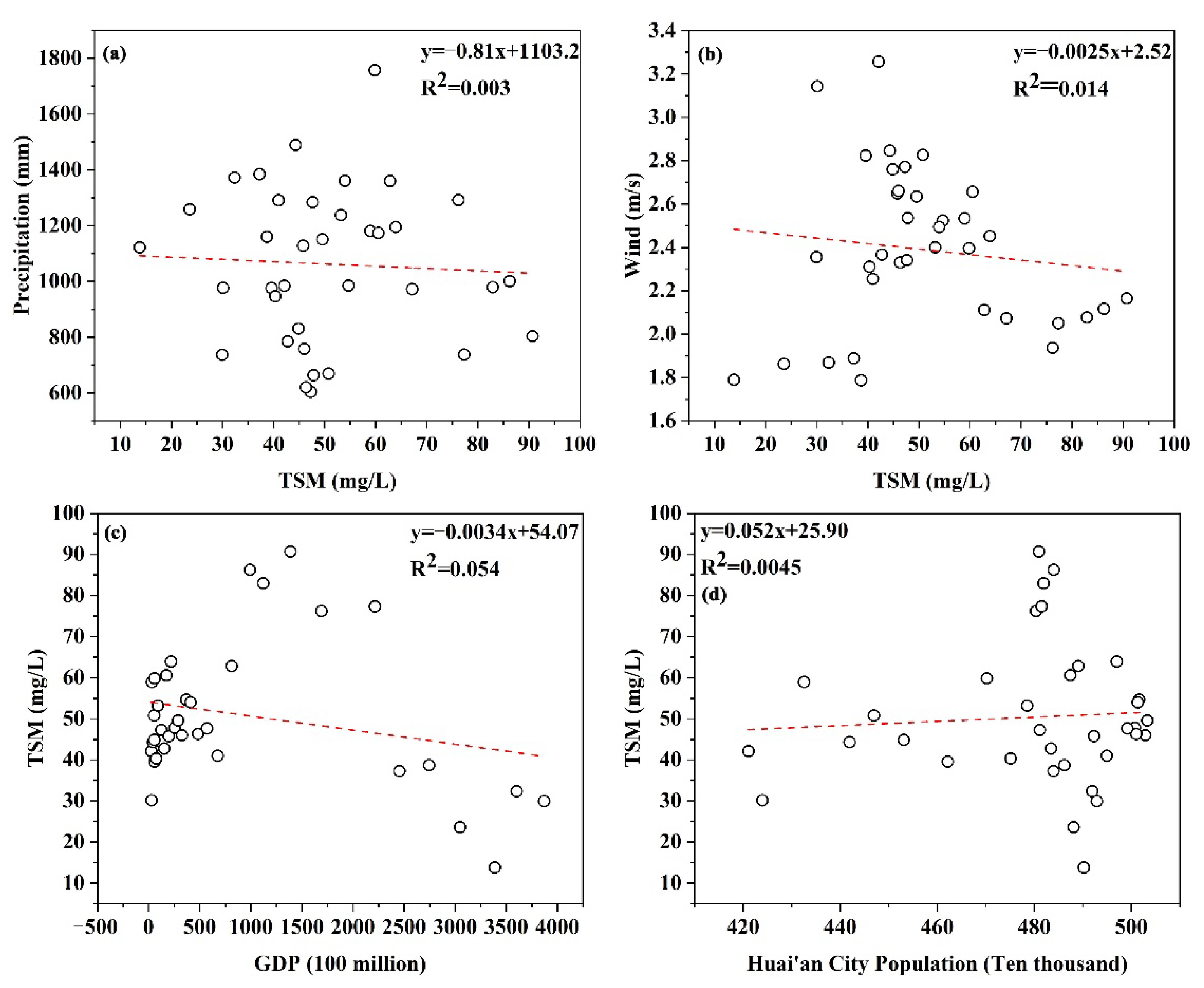
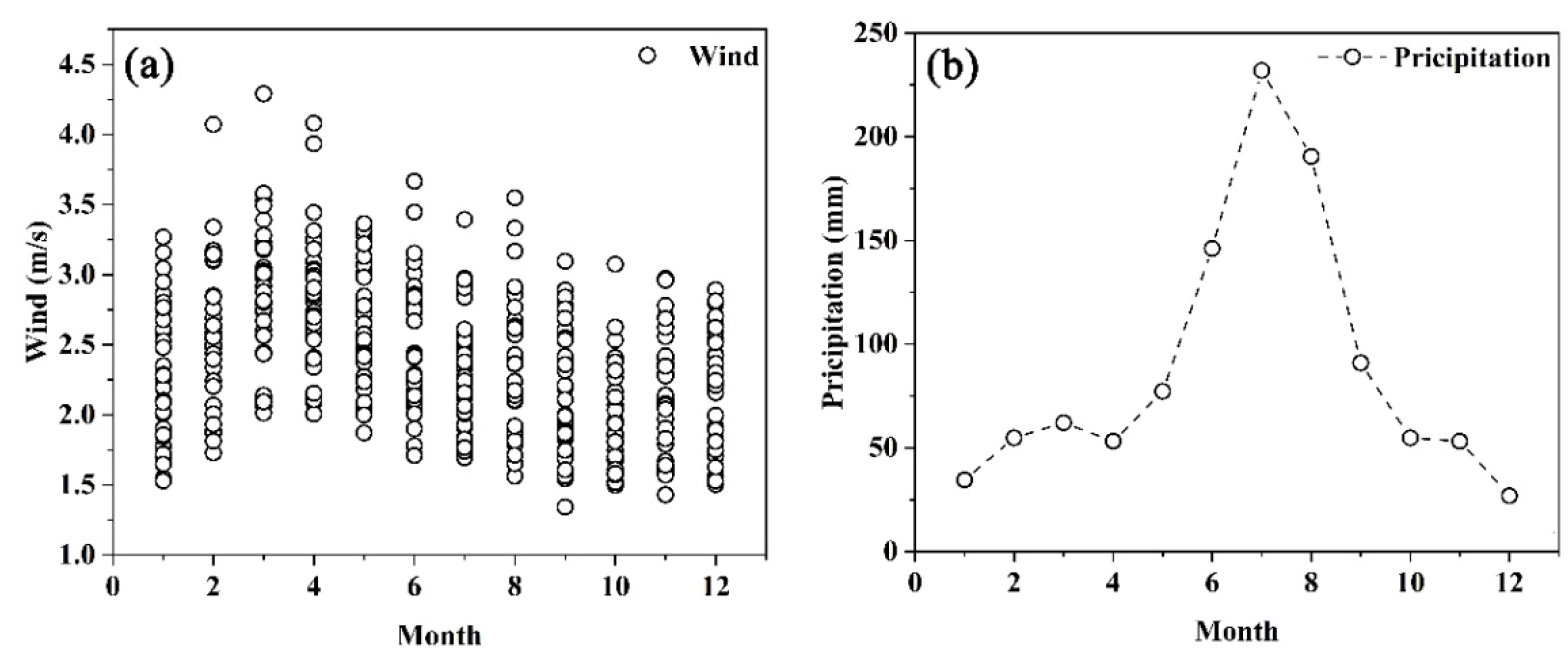
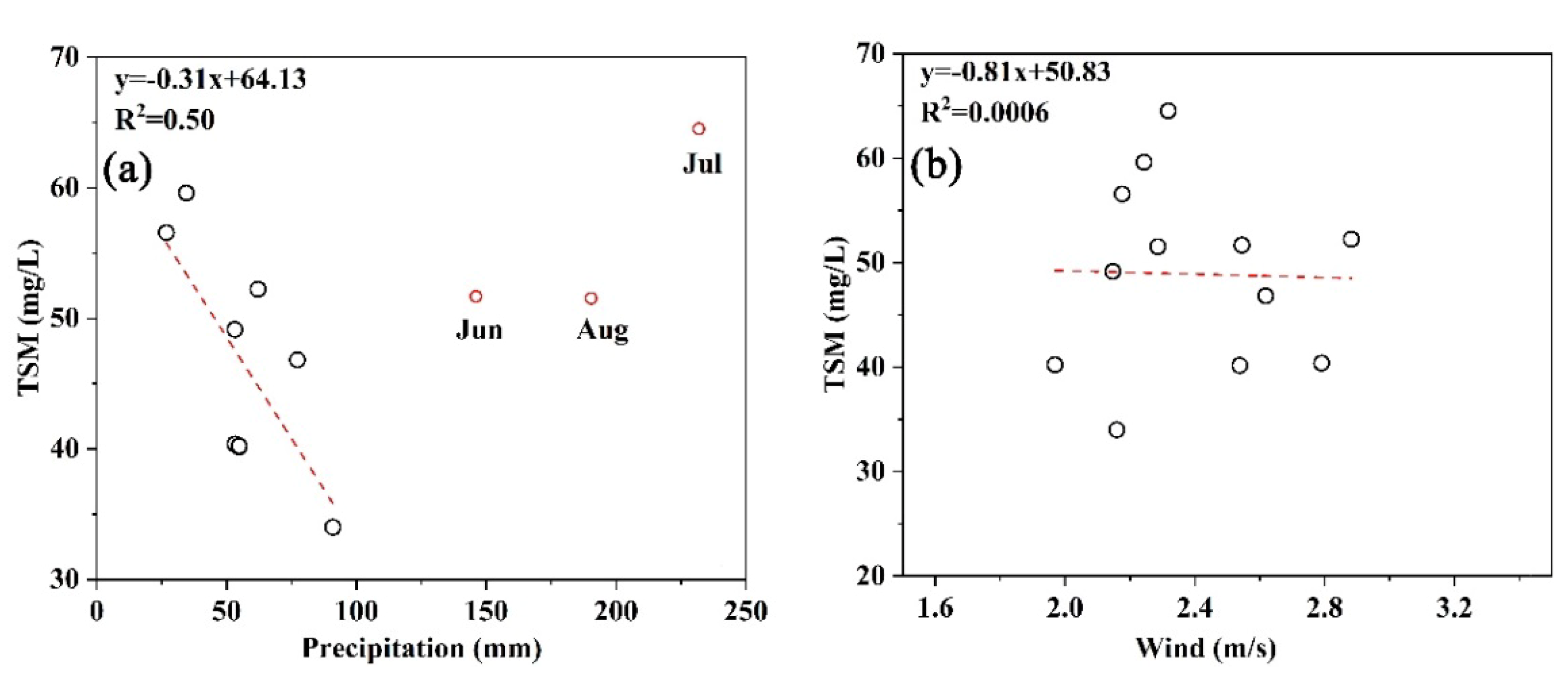
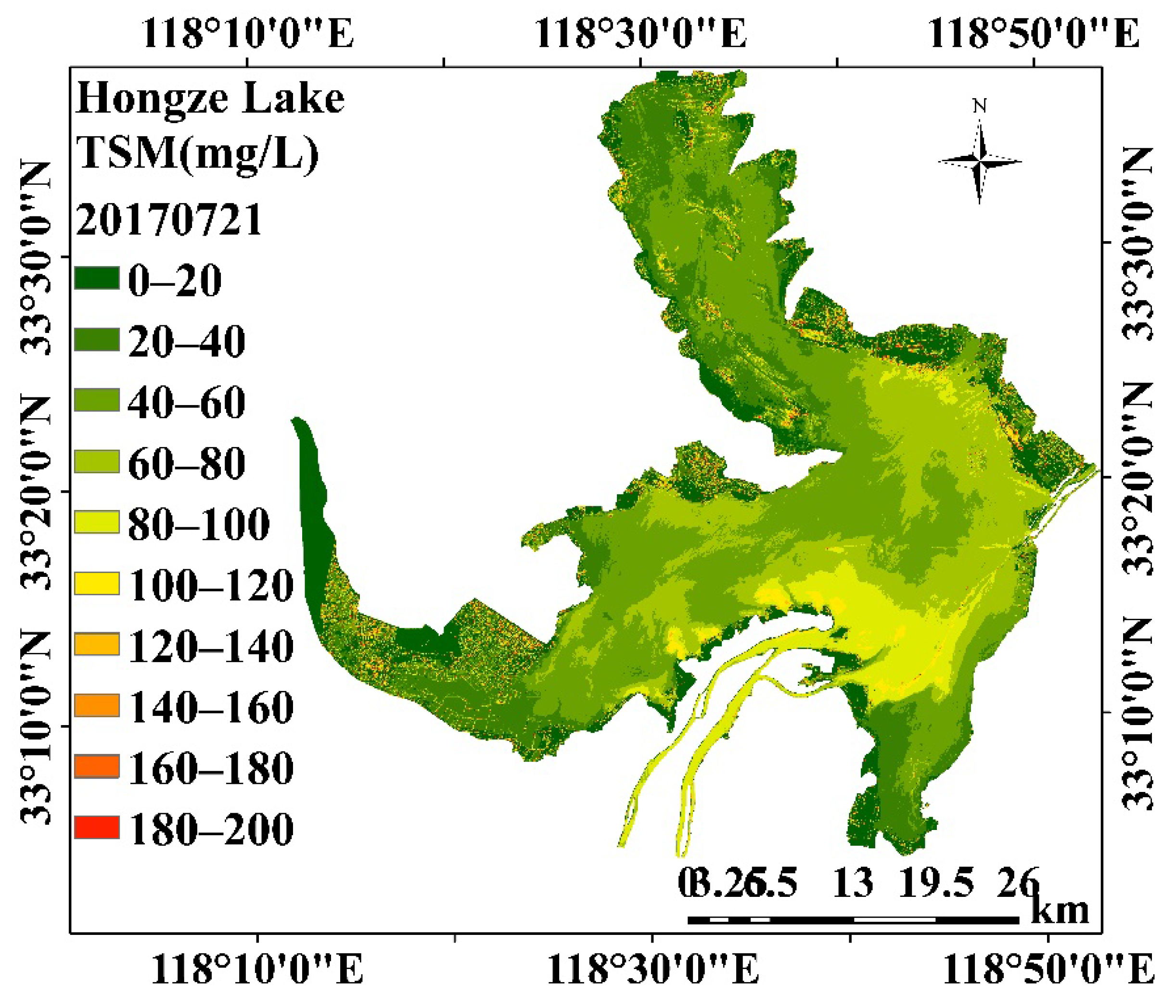
| Year | Month | Year | Month |
|---|---|---|---|
| 1984 | 6, 7, 8, 9, 10 | 2000 | 7 |
| 1985 | 5, 10 | 2001 | 7 |
| 1986 | 7, 9 | 2003 | 6, 7 |
| 1987 | El Nino | 2005 | 7 |
| 1991 | 5, 6, 7, 8 | 2007 | 6, 7 |
| 1996 | 8, 10 | 2009 | El Nino |
| 1997 | 7, 8 | 2011 | 8 |
| 1998 | 8 | 2019 | 8 |
Publisher’s Note: MDPI stays neutral with regard to jurisdictional claims in published maps and institutional affiliations. |
© 2022 by the authors. Licensee MDPI, Basel, Switzerland. This article is an open access article distributed under the terms and conditions of the Creative Commons Attribution (CC BY) license (https://creativecommons.org/licenses/by/4.0/).
Share and Cite
Du, C.; Li, Y.; Lyu, H.; Shi, K.; Liu, N.; Yan, C.; Pan, J.; Guo, Y.; Li, Y. Characteristics of the Total Suspended Matter Concentration in the Hongze Lake during 1984–2019 Based on Landsat Data. Remote Sens. 2022, 14, 2919. https://doi.org/10.3390/rs14122919
Du C, Li Y, Lyu H, Shi K, Liu N, Yan C, Pan J, Guo Y, Li Y. Characteristics of the Total Suspended Matter Concentration in the Hongze Lake during 1984–2019 Based on Landsat Data. Remote Sensing. 2022; 14(12):2919. https://doi.org/10.3390/rs14122919
Chicago/Turabian StyleDu, Chenggong, Yunmei Li, Heng Lyu, Kun Shi, Naisen Liu, Chen Yan, Jinheng Pan, Yulong Guo, and Yuan Li. 2022. "Characteristics of the Total Suspended Matter Concentration in the Hongze Lake during 1984–2019 Based on Landsat Data" Remote Sensing 14, no. 12: 2919. https://doi.org/10.3390/rs14122919
APA StyleDu, C., Li, Y., Lyu, H., Shi, K., Liu, N., Yan, C., Pan, J., Guo, Y., & Li, Y. (2022). Characteristics of the Total Suspended Matter Concentration in the Hongze Lake during 1984–2019 Based on Landsat Data. Remote Sensing, 14(12), 2919. https://doi.org/10.3390/rs14122919







